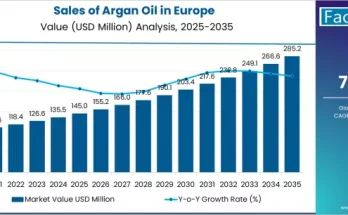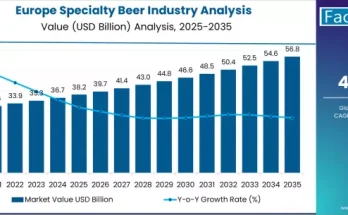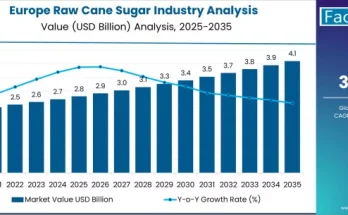The global fractionated pulses market stands at the threshold of a decade-long expansion trajectory that promises to redefine plant-based ingredient technology and sustainable protein innovation. According to a recent report by Fact.MR, the market is projected to grow from USD 3.1 billion in 2025 to USD 5.3 billion by 2035, marking a CAGR of 5.5% during the forecast period.
As global consumers and food manufacturers increasingly pivot toward cleaner labels, alternative proteins, and sustainable nutrition, fractionated pulses are emerging as a key ingredient across food, beverage, and feed applications. Their rich nutritional value, functional versatility, and environmental advantages are transforming the global food system.
Strategic Market Drivers
- Surging Demand for Plant-Based Proteins
The accelerating shift toward vegetarian, vegan, and flexitarian diets is reshaping protein consumption patterns worldwide. Fractionated pulses, derived from lentils, peas, chickpeas, and beans, are being leveraged for their high protein, fiber, and micronutrient content.
Food manufacturers are incorporating pulse-derived proteins and starches in meat substitutes, dairy alternatives, bakery, and snack formulations — delivering clean-label, allergen-free, and sustainable nutrition. - Functional and Nutritional Superiority
Fractionated pulses offer superior emulsifying, water-binding, and texturizing properties compared to traditional protein sources. These functional advantages are driving adoption in high-performance food applications such as sports nutrition, infant foods, and ready-to-eat meals.
The combination of nutritional density and processing adaptability positions fractionated pulses as a critical component of next-generation food innovation. - Sustainability at the Core
Pulses are naturally nitrogen-fixing crops that improve soil health and require significantly less water than animal-based protein production. As sustainability becomes a central focus for global food manufacturers, fractionated pulses are being adopted as eco-friendly ingredients that reduce carbon footprints and support regenerative agriculture. - Expansion into Non-Food Applications
Beyond the food sector, pulse fractions are gaining traction in cosmetics, pharmaceuticals, and pet food for their bio-functional and biodegradable characteristics. Their starch and protein derivatives are increasingly used in natural formulations, replacing synthetic components.
Browse Full Report: https://www.factmr.com/report/4902/fractionated-pulses-market
Regional Growth Insights
North America: Innovation and Clean Label Momentum
The U.S. and Canada remain frontrunners in plant-based innovation, with strong investments in pulse processing infrastructure. Consumer preference for high-protein, allergen-free foods and government support for sustainable agriculture are driving rapid adoption of fractionated pulse ingredients.
Europe: Regulatory Support and R&D Excellence
Europe’s stringent sustainability and food labeling regulations are fueling demand for traceable, low-impact ingredients. The region’s robust R&D ecosystem, particularly in France, Germany, and the U.K., is leading advancements in pulse protein extraction technologies and functional ingredient development.
Asia Pacific: Emerging Processing Powerhouse
Countries like India, China, and Australia are capitalizing on their strong pulse cultivation base to expand value-added processing. Rising disposable incomes, coupled with increasing awareness of health and wellness, are boosting demand for high-protein and plant-based food products in the region.
Latin America and the Middle East & Africa: Rising Agricultural Integration
Emerging markets are witnessing increasing investment in pulse-based protein plants and ingredient innovation. Strategic collaborations between regional growers and global food manufacturers are strengthening supply chains and boosting export potential.
Market Segmentation Insights
By Product Type
- Protein Concentrates and Isolates – High adoption in sports nutrition and plant-based meats.
- Starch Fractions – Utilized for texture improvement and clean-label formulation.
- Fiber Fractions – Growing use in digestive health and functional food products.
By Application
- Food & Beverage – Dominant segment, driven by the rise in alternative proteins and fortified foods.
- Animal Feed – Used for sustainable livestock nutrition.
- Pharmaceuticals & Nutraceuticals – Emerging segment leveraging functional pulse derivatives.
Challenges and Market Considerations
- Processing Complexity: Pulse fractionation requires high capital investment and advanced technology for protein isolation and purification.
- Supply Chain Constraints: Dependence on seasonal crop yields impacts raw material consistency.
- Taste and Sensory Limitations: Off-flavors and textural challenges require continuous innovation in flavor masking and product formulation.
- Competition from Soy and Pea Proteins: The market faces stiff competition from established plant protein sources with large-scale production capacity.
Competitive Landscape
The global fractionated pulses market is characterized by technological innovation, capacity expansion, and sustainability-driven differentiation. Key players are focusing on improving extraction efficiency, enhancing product purity, and expanding regional processing capabilities.
Key Companies in the Fractionated Pulses Market:
- Roquette
- Ingredion
- ADM
- Bunge
- AGT Food and Ingredients
- Cosucra
- Emsland Group
- Kerry Group
- Tate & Lyle
- Axiom Foods
These companies are actively investing in AI-based process optimization, clean-label formulation technologies, and regional partnerships to strengthen supply networks and deliver tailored protein ingredients across markets.
Future Outlook: Building a Sustainable Protein Ecosystem
The next decade will mark a turning point for the fractionated pulses industry, as food producers and ingredient suppliers align around sustainability, transparency, and innovation.
Advancements in dry and wet fractionation technologies, coupled with increasing consumer awareness of plant-based nutrition, will continue to unlock new opportunities across multiple sectors.
As the global demand for sustainable protein accelerates, fractionated pulses are set to play a defining role in shaping the future of food — enabling healthier diets, cleaner production systems, and a resilient global food economy.



